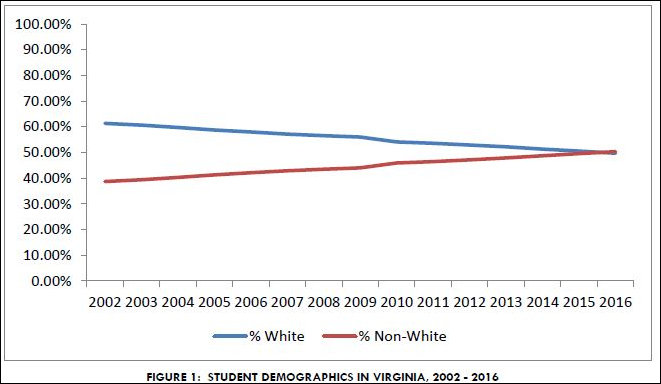
Source: “Report on the Recommendations of the Taskforce to Diversify Virginia’s Educator Pipeline.”
Seeking to close the educational achievement gap between whites on the one hand and African-Americans and Hispanics on the other, the Virginia Department of Education has found a new focus: an insufficient number of “teachers of color.”
Even as the number of minorities in Virginia schools now equal the number of whites, Virginia’s teachers are becoming “less diverse over time,” states a report of the Taskforce to Diversify Virginia’s Educator Pipeline made to the Virginia Board of Education. “Demographically, minority students make up 48.7 percent of Virginia’s student population, but only 21.4 percent of the state’s teachers are minorities. Research indicates that a racially representative mix of teachers and administrators can be directly correlated to positive educational outcomes for minority students.”
In Virginia’s school system, diversity has become an end unto itself. “All Virginia students benefit personally and intellectually when they learn from education professionals with a variety of racial, ethnic, socio-economic and religious backgrounds,” states the report. “We believe there is value in all students learning from teachers with diverse backgrounds; and we simultaneously recognize that research indicates there is a unique role teachers of color play in improving the lives of students of color.”
The task force says Virginia should endeavor reduce the gap between the percentage of minority students and the percentage of minority teachers, now 27%, to 15% by by 2040.
There are two problems, states the report. First, according to national statistics, teachers of color leave the profession at a higher rate than whites: 18.9% per year turnover in 2012-13 compared to 15% for white teachers. Second, the percentage of minority students enrolled in education schools is declining. “Minority enrollment in Virginia’s teacher preparation programs has fallen from more than 50 percent in the 2010-2011 school year to only 33 percent in 2016-2017.”
The task force’s proposed solution is to remove barriers to minority students seeking to become teachers. The conventional pathway to the teaching profession entails a five-year program for a B.A. and M.A., during the course of which the average Virginia teacher will have accrued $50,879 in debt. States the report: “When combined with low teacher pay, the high cost of training is a powerful deterrent for young people considering a future in the teaching profession.”
The state should revise its criteria so that students can become teachers through development of a four-year undergraduate major. Also, Virginia should provide financial assistance for minority teaching candidates, give student teaching stipends to low-income students, and devise innovative ways to provide compensation to student teachers during their student-teaching experience. Other solutions include encouraging minority high school students to become teachers and making more of provisional licensure.
Bacon’s bottom line: Wow. It’s hard to know where to begin. Let’s start with the bedrock assumption that “diversity” among teachers is a meaningful determinant in the educational outcomes of students. I’d like to evaluate the “research” that stands behind this proposition as well as any that might contradict it. If the ethnic identity of teachers and students is so crucial, I’d especially like to see how the research explains that Asian-American students consistently out-perform whites academically even though the number of Asian-American teachers is a tiny percentage of the whole.
But let’s accept the report on its own terms, including the proposition that the ethnic identity of the teacher matters. One might ask why minority teachers leave the teaching profession at a higher rate than white teachers. Do we know why they are leaving? Has anyone asked the minority teachers why they are leaving? The Task Force does not consider option of reducing teacher turnover, choosing to focus exclusively on the supply of new students.
Interestingly, the Task Force might have a point about the educational pathway for new teachers. Perhaps the requirements are too high — not just for minority teachers but all teachers. After all, as the task force notes, the problem schools have recruiting minority teachers is just a sub-set of the difficulty they have recruiting teachers in general. Who put these barriers into place? Did the Virginia Teachers Association play a role? Assuredly, the justification proffered for instituting more demanding standards was to improve the quality of teachers, but according to public choice theory, the hidden purpose was to restrict the supply of new teachers. Labor shortages give teachers more power to mau-mau state and local government for higher salaries and benefits. If the Task Force prompts legislators to take a look at the entire system of teacher credentialing, it might have done us all a favor.
The high cost of getting a teaching degree also circles back to a perennial issue of interest to Bacon’s Rebellion — the excessive cost of education. Why is it so expensive to teach students how to teach? What is going on inside Virginia’s schools of education? Should not part of the solution be to bring tuition back to reasonable levels?
The Task Force addresses none of the broader issues, and that’s a missed opportunity. Among all the factors that influence academic achievement among African-Americans and Hispanics, I would be willing to bet that the ethnic mix of teachers is secondary at best. I would be amazed if closing the ethnicity gap between teachers and students has any measurable effect whatsoever. Indeed, the obsession with racial bean counting strikes me as part of what is wrong with public education today.


